Samsung Q70R
Product Name: Samsung Q70R
Product Description: 2019 4K UHD LCD TV
-
Design - 8.9/10
8.9/10
-
Video Quality - 9/10
9/10
-
Inputs and Ports - 8.8/10
8.8/10
-
OS, Apps and Features - 9.5/10
9.5/10
-
Price / Quality - 9/10
9/10
Summary
Total Score
Pros
- Very good image quality and HDR
- Extremely low input lag
- Huge list of features and services
- Good price
Cons
- No Dolby Vision support
- Viewing angles are poor
- Sound quality is average
- No One Connect Box
Cheapest Places to Buy :
*We are a reader-supported website. When you buy through links on our site, we may earn a small affiliate commission at no extra cost to you. Home Media Entertainment does not accept money for reviews.*
In today’s review we will be looking at another TV belonging in the 2019 QLED series which has left us with overall good impressions so far. With LG dominating the scene with their OLED panels Samsung is really pushing LCD technology to their limits in order to stay competitive at least as far as image quality is concerned. And even though LCD may not be exactly on the same league as OLED, Samsung has really impressed us with the improvements they managed to make to this aging technology and the result can be described as more than just satisfactory.
The Q70R has a unique position in the QLED series. It may come third in line behind the top Q90R and Q80R models which means that some specifications are lower and as a result this has an obvious impact on the quality of the images the TV can display but on the other hand it keeps some hardware characteristics of it’s bigger brothers in order to offer a very satisfactory result at a much better price. The Q70R is the most affordable QLED that comes with a FALD system which is very important for it’s good performance. All other models under this one have edge lit panels which means much lower light precision and control.
Coming with a lower performing FALD system, less brightness and no Ultra Viewing Angle filter can the Q70R still be a competitive model worthy of the QLED title or the lower specifications make this model loose some of the thunder of the top flagships? Keep reading our Samsung Q70R review as we test every aspect of this TV to find out.
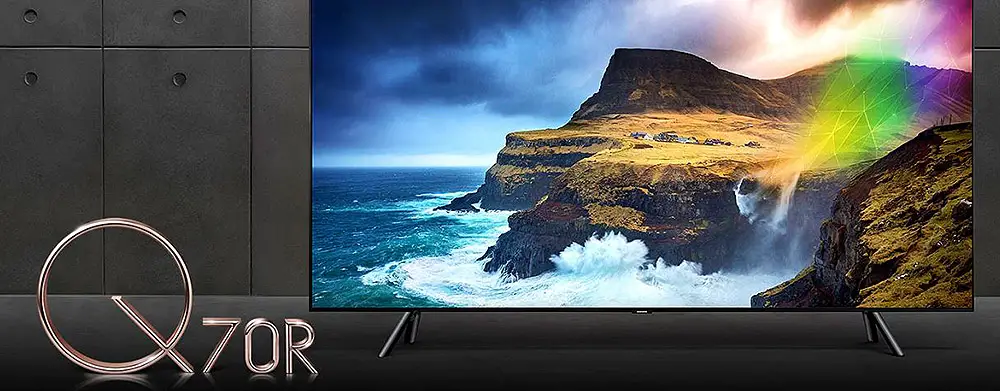
Design
When we reviewed the Q80R to our great disappointment we saw that there was no One Connect Box as it turned out only the top Q90R would get it in the US (as well as the Q85R in Europe). So this time we knew not to expect it with our Q70R model which is a bummer really and we do hope that in the future Samsung will decide to use it in more of their models. Since they advertise their QLED series as the premium one we would at least expect all of them or at least most of them to use such a unique and so practical feature.
As for the actual TV the Q70R keeps a relatively thin design even though it’s FALD system increases it’s thickness a bit while most of the TV’s body keeps it’s uniformity with only a slight curve towards the top. This model unfortunately does not support the no-gap wall mount of the Q90R but in general we cannot say it looks bad even though it will stick out from the wall a bit more than what we would like.
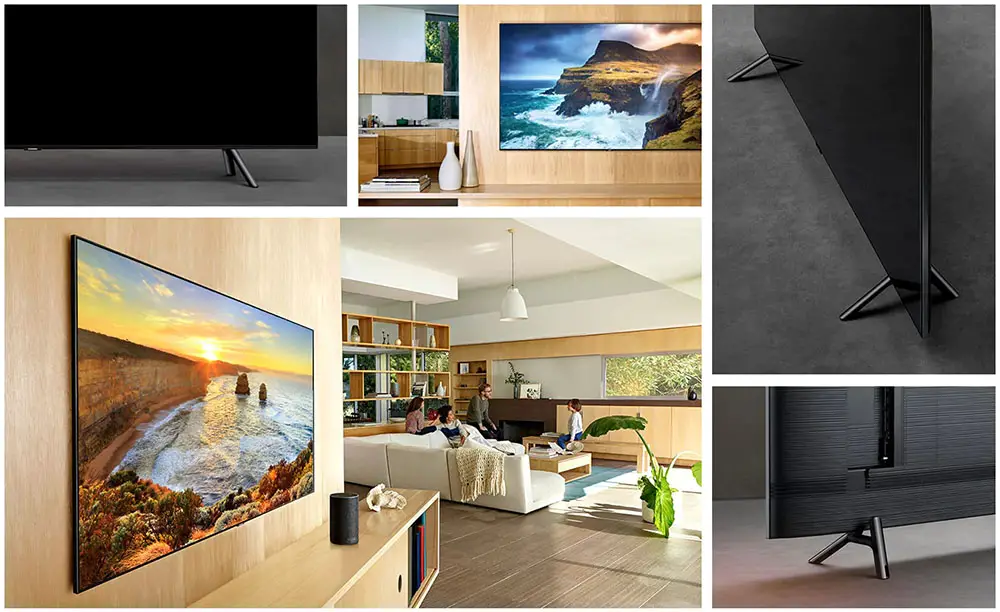
The back of the TV is very similar to last year’s Q8FN with the same plastic body, similar texture, the same position of the connections as well as cable management. For the cables Samsung has added special grooves on the back to guide them if you want to wall mount. If you prefer to place it on a furniture then the Q70R comes with a bench type stand which is preferable for such a TV in order to keep it stable although it may be a bit of a problem if you have limited space to place it on. The back of the stand has grooves in order to hide the cables and this is where cable management ends with this TV. Nothing fancy but the best that can be done since there is no One Connect Box.
As for the remote the one supplied with the Q70R is the same as the one we get in the US variant of the Q90R. This is the gun-metal black arch variant that is similar to most One Remotes we had seen in the past. The difference we find here compared to older models is the three dedicated buttons under the channels and volume control buttons with Netflix, Prime Video and Hulu available. Since the remote works with Bluetooth it doesn’t need direct line of sight to work while it can act as a universal remote either if your other equipment support HDMI CEC or not as it also comes with IR capabilities. Additionally with the included microphone you can issue commands to Bixby even if the TV is close which is a neat feature.
Good overall quality both for the TV and the remote and while missing the One Connect Box is disappointing what we do get show the attention Samsung puts on the QLED models.
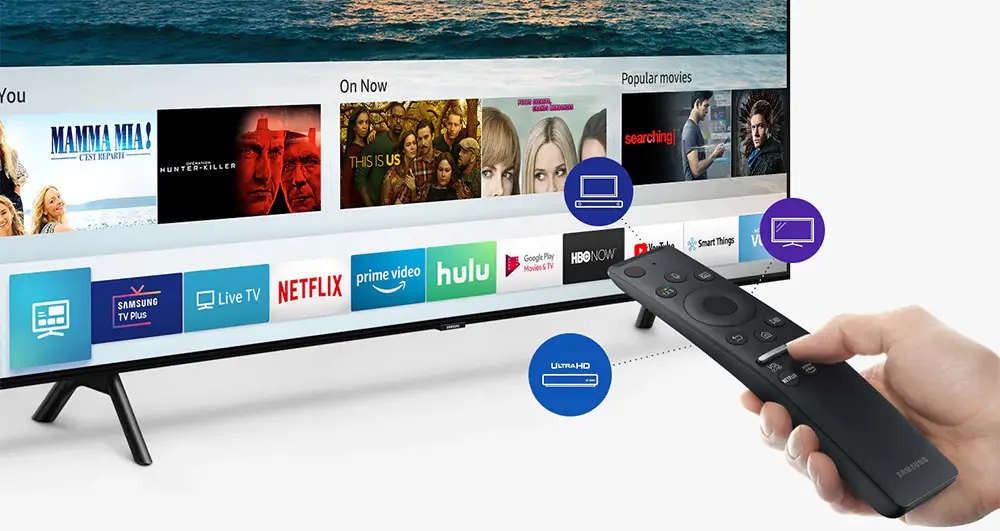
Video Quality
Processor technology used
As with all the QLED series in 2019 the Q70R comes equipped with the same Quantum Processor 4K that we saw in both the Q80R and Q90R flagships in our recent reviews. This means that the Q70R also comes equipped with a powerful AI upscaling engine that uses some complex algorithms and in addition to an image database that it can access it is capable of upscaling lower resolution content to 4K with amazing results.
Having the same hardware as the top tier models means that as far as upscaling is concerned the kind of quality we get here is exactly the same. We tried content in different resolutions like SD as well as Full HD and the Q70R made a very good job upscaling all of them to 4K with no additional artifacts visible. Of course Blu-ray discs fared better as some films scaled amazingly in our screen while colors and sharpness were produced faithfully. SD content was also good but there is so much you can do with so low quality content. Great work from the Q70R here.
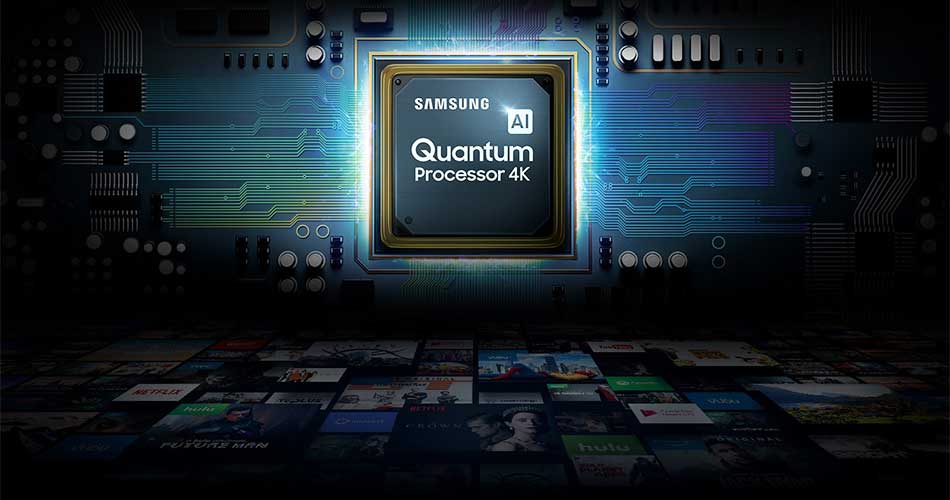
Lighting technology used
It seems that this year almost the complete QLED lineup, except the lowest Q60R, comes with some kind of Full Array LED panel with dimming zones as a FALD system no matter how accurate it is, can provide a vastly superior image quality to TVs that come with Edge lit panels. As such we are pleased to see that even the Q70R comes with a FALD system which is impressive really if you consider that just a couple of years ago only the top flagships were coming with FALD and everything else had to settle with the inferior Edge lit panels.
Of course how good a FALD system is depends on 2 factors. First how many dimming zones it comes with as the more zones allow for more precise and better light control while the second depends on the lighting algorithms that control how fast each zone will change it’s light output. The number of zones is a hardware matter and it seems that in order for manufacturers to manage the cost of the TV panel they decide how many zones to include. This means that flagships get more zones than lower models.
A result of this can be seen when you have a very bright object against a dark background. The lesser the zones a more visible halo will appear around the object as the light escapes to the nearby pixels. As for the light algorithms they control the response time of the dimming zones. The faster the change the less visible ghosting you can see when a bright object moves very fast on a dark background.
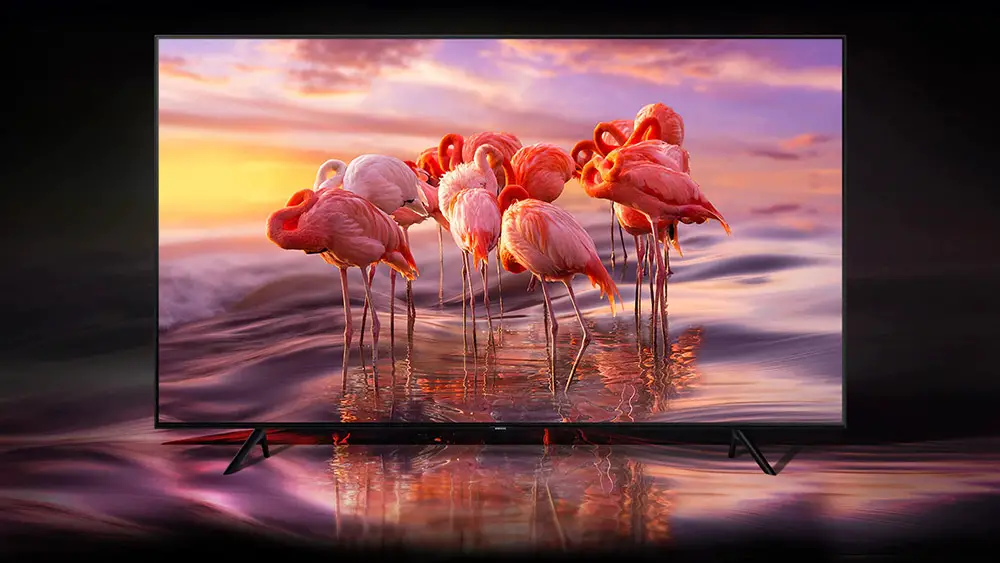
Returning to our Q70R testing we measured the number of dimming zones to 48. This means that compared to the Q80R that we had tested recently the Q70R cuts the number of zones to just half of them. In theory this may sound bad but in all honesty you have to see the result to understand that even with just 48 zones the TV can perform very well. We have said before that we would take any FALD system compared to Edge lit ones so even if the lower number of zones offer less light accuracy we are still happy with the end result if you also take into account the lower price of the Q70R compared to the Q80R or even Q90R.
As far as the response time the Q70R fared good but there is a small delay between transitions and this can be seen more clearly when a bright object disappears. Then the dimming zone remains lit for a fraction of time before it’s turned off that can be a bit distracting. Of course during normal viewing this effect will not be very visible but the problem is there and we should mention it.
Brightness / Contrast
With the Q70R we see a further reduction in brightness compared to the higher Q80R model as the theoretical brightness here is 1,000 nits. With Local Dimming set to high and Color Tone to Warm 2 we measured HDR brightness over a 10% windows to 740 nits which may be a far cry from the 1,000 nits claimed but still remains a respectable number in order to show very bright highlights and good overall brightness. Next we measured SDR brightness over a 10% window and here we got 510 nits which is great for any kind of SDR content since requirements are not so high.
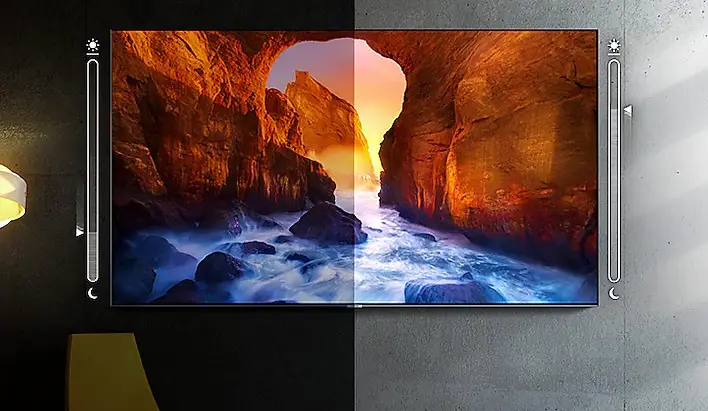
Additionally contrast ratio of the Q70R was very good as the TV was able to display very deep blacks but we have a small suspicion that this is also a result of the TV missing the Ultra Viewing Angle layer that we had seen in both the Q80R and Q90R that was improving viewing angles but had a negative impact on contrast ratio. Here this layer is missing and it could also help a little in this regard.
Viewing angles
The Q70R comes with a VA panel which means that viewing angles are in general not good. And while Samsung managed to improve this a bit with the Q80R and Q90R models as these models included the Ultra Viewing Angle we mentioned before the Q70R is the first model in the series that looses this extra layer and as a result image quality drops significantly when you move anything more than 20-25 degrees off-center making this TV less than ideal if you plan to use it from high angles.
HDR support
Talking about HDR support what we write here applies to all 2019 models. Samsung is following a very specific policy by taking the decision not to support Dolby Vision at all and instead they will try to push their own advanced HDR with metadata called HDR10+. If this is a strategy that will pay off it remains to be seen but for the meantime as with all Samsung TVs the Q70R supports HDR10 which is the basic protocol for UHD playback, HLG which is used in broadcasting as well as the new HDR10+ with it’s dynamic metadata. We are slowly seeing a few UHD releases using this new protocol and we are curious to see if it will gain as much traction as it’s rival Dolby Vision.

Color coverage
The Q70R supports wide color gamut which means it can display more colors on screen for more lifelike images. Unfortunately it seems that color coverage is slightly lower than the Q80R but also last year’s Q7FN. According to our measurements the TV can cover around 91% of the DCI-P3 color space and about 69% of the wider REC.2020. Although this is not immediately visible to the naked eye the numbers reveal the lower performance this panel has compared to the top models in the series.
Motion performance
The Q70R showed a very similar behavior in the motion department as the top flagships we had tested before in the QLED series. In a similar fashion the Q70R comes with a 120Hz panel while it’s backlight dimming frequency is at 960Hz resulting in delivering clear and blur free images even in very fast camera movements.
Additional features we get is the standard motion interpolation for creating smoother images and this can be adjusted from the Auto Motion Plus menu but pushing the settings to high levels can make the “Soap Opera Effect” to appear. Usually some low setting is the most preferable but you have to test various settings to find the most suitable for you. We also find the BFI (Black Frame Insertion) feature that smooths motion by inserting a black frame between 2 individual frames. Although the end result is very good the side effects of this is that brightness is lowered while some people may notice a bit of flickering even though this can be rare.
As with the other QLED flagships, the Q70R also supports FreeSync variable refresh rate technology if you have other equipment that also supports it.

Input lag
Another characteristic of this year’s QLED series seems to be the extreme low input lag that all models have and the Q70R seem to follow the same trend as we measured 15.7ms input lag with the Game mode enabled which is very close to what we had seen during our Q80R and Q90R reviews. We connected our PS4 to the TV and Game mode engaged automatically as it detected our console immediately. The game we like to try lately is Call of Duty WW2 which has a fast enough gameplay in order to get a sense of the kind of response we would get. Needless to say that our session was smooth as butter and our gamepad inputs were instant and precise. If you are a gamer you will fall in love with this TV for sure.
Image quality impressions
Having already tested the Q80R and Q90R flagships we more or less knew what to expect from the next in line model. The Samsung Q70R has a FALD system with all the benefits this brings but it’s fewer dimming zones offer less light accuracy while response time of the Local Dimming was average as when a bright object would disappear the dimming zone would remain lit for a fraction of time before disabled. Brightness was also lower but is in line with what we were expecting in this category. Missing the Ultra Viewing Angle Layer meant that viewing angles would be much worse and anything more than 20 degrees would start to make the image loose quality. Color coverage and contrast good enough while input lag was amazing.
In this price range we believe that Samsung made a very good job with the Q70R’s main strength being by far the inclusion of the FALD system. Just a few years ago FALD would be a flagship exclusive feature but now it seems this is becoming the norm for even middle tier models which is only a good thing for the consumers.
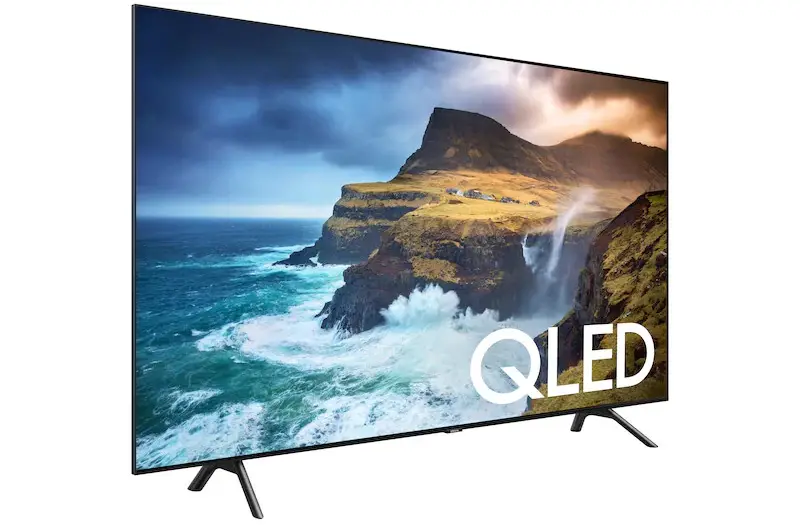
Audio Quality
Downgrades in image quality is not the only thing we find in the Q70R compared to the top flagships as the audio system also is downgraded to a simpler 2.1 channels system with a total of 40 watts power. Being more thick due to the included FALD system it means that there is a bit more breathing space for the down-firing speakers but even like that don’t expect anything fancy. For casual viewing the audio is good enough with clear dialogue and audio in general but it cannot produce any kind of surround immersion while bass fails to produce any kind of rumble.
Since the TV comes with the Quantum Processor 4K it means it also comes with Samsung’s “Intelligent Sound” which is a feature which we had seen in both the Q80R and Q90R and what it does is analyze the environment the TV is placed and the type of content it displays and optimizes the sound accordingly for the best possible immersion. In action films for example this feature seems to boost the surround effects a bit in order to create a wider soundstage while during talk shows and news broadcasting dialogue is more pronounced. If you are a sports fan then this system boosts the crowd effect in order to make you feel more in the game.
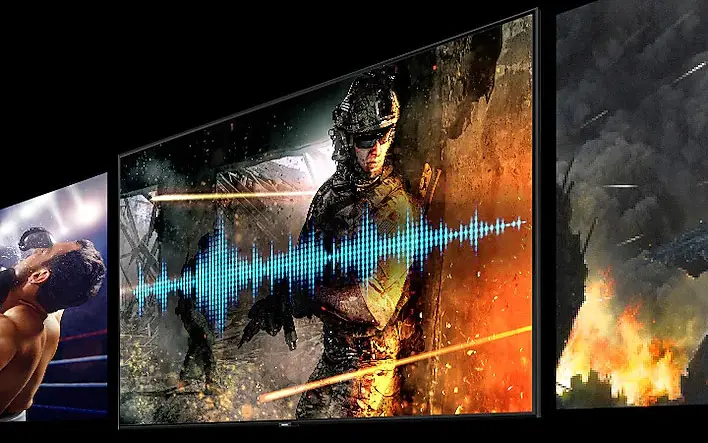
We have said in our previous tests that this feature while altering a bit the overall result, it doesn’t have the necessary hardware to work with in order to offer a dramatically different outcome. Yes small differences there are and depending on what you watch the sound will feel a bit different just don’t expect to see night and day differences. But with such a low performing system like any flat TV has any kind of improvement is welcome so we are glad with what Samsung tried to do here. But for a true improvement in audio we will definitely recommend a dedicated audio system or at least a soundbar.
Inputs
The Q70R unfortunately is missing the miracle One Connect Box that the Q90R as well as the European Q85R variant have. Here all connections are placed in the back left side of the main body with the total of connections looking sideways in order to make them a bit easier to access if you plan to wall mount it. QLED is supposed to be the premium TV series and in our opinion all models should come with the One Connect Box but unfortunately this is not the case.

What we do get is a fairly standard setup with 2 USB 2.0 ports, a Digital Optical Audio output, 4 HDMI ports with all of them being HDCP 2.2 while HDMI 4 also comes with ARC support. There is also an Ethernet port, an Ex-Link jack and the usual Antenna port. Not much to say here as we still are getting the archaic USB 2.0 ports, there is no eARC to be found as non of the ports are HDMI 2.1 and lastly the most important is the omission of the One Connect Box. We cannot say we are very excited by what is on offer by what is supposed to be the third best TV from Samsung in 2019.
OS, Apps and Features
As far as it’s smart TV functionality and features the Q70R comes with the same capabilities as the other models in the series which we had extensively tested during our Q80R and Q90R reviews.
Samsung has equipped all their 2019 QLED models with the latest Tizen smart TV platform which in our opinion is the best smart platform available along with LG’s webOS. And although the last few years we don’t see major changes Samsung makes sure to update their OS with enough visual and some new elements to keep it fresh and more functional than ever.
Initial setup could not be easier as you follow the directions on screen in order to connect to the internet as well as calibrate all broadcasting channels. When done you are ready for use, it’s so easy that it shouldn’t take more than a few minutes. If you have used any previous Samsung TVs then more or less know what to expect as the general look and feel is not very different over the years. What is different is the visuals as the latest version comes with a more pleasing design although fundamentally is the same making navigation easy and fast.

At the bottom of the screen a launcher bar appears that extends from side to side showing all apps and services in a single line while a second layer appears providing quick access to various content and applications. The huge amount of available apps makes customization a necessity in order to keep everything in order and be able to find what you seek easily.
Amazon, Youtube, Netflix, Demand 5, Rakuten, Now TV and BBC iPlayer are just a few of the available services as mentioning everything is impossible. So much support there is from developers which is one of the things that make Tizen such a great platform. For this year we can also use Amazon, Youtube and Netflix to stream 4K content with HDR which is a plus for anyone with a good internet connection. Navigation was more or less smooth although we did see the same lag when trying to open quickly various applications that we saw when testing the Q80R but it’s not very bothersome and happened just a few times so we don’t consider this something major.
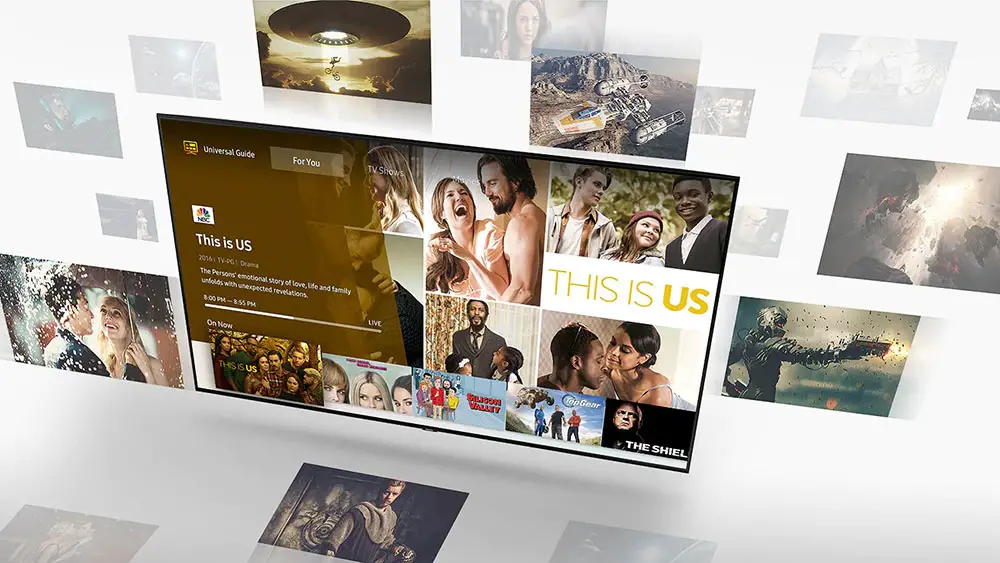
One nice new feature we found in 2019’s Tizen is the inclusion of Samsung’s “Universal Guide” which is a system that analyses the content you are viewing the most and creates a ‘For You’ page which can be very useful if you are using many streaming services and you are looking for your favorite show. Very nice feature and one that was definitely needed in order to keep all your favorite content together.
Another feature we find for one more year is the Ambient mode which was initially used in “The Frame” and since then Samsung has included it in most middle and top tier TVs every year. What this feature does is that by displaying specific images it tries to blend the TV with the environment when not in use. The end result depends heavily on the image quality and also keep in mind that the TV still uses power to work so it’s not the perfect feature that you may think. Nevertheless some may like it so it’s good to see it included as a standard.

As our times dictate electronic equipment should give you various control options and as such a 2019 TV couldn’t do otherwise. The included remote could be the most usual way but Samsung has also created the SmartThings app that you can download in your mobile device and with it not only control your TV but also any smart devices in your house. But if you prefer an even more advanced way of control then the Q70R comes with support for both Amazon Alexa and Google Assistant in addition to Samsung’s Bixby. But for Alexa and Google Assistant you will need a dedicated device like an Echo Dot or Google Home while for Bixby you can use the remote’s microphone to function.
New for this year is also support for Apple TV with which you can stream various content from the Apple store while the inclusion of Airplay 2 let you stream content from any Apple device to your TV while control can be done with Apple’s Siri.
Final Thoughts
There are so many things to like with the Q70R. Even with it’s lower specs this unit packs a lot of features that in the end if you also consider it’s price it becomes a no brainer. This is the most affordable TV in Samsung’s arsenal that has a FALD system giving a vastly better and accurate light control over any kind of edge LED TV. It also comes with the new Quantum Processor 4K that has amazing upscaling capabilities as well as AI features for image and sound. Feature wise this model doesn’t miss anything of it’s bigger brothers providing one of the most comprehensive smart TV platforms to date. With good color coverage, good brightness both in SDR and HDR and extremely low input lag the Q70R comes with the right features and the right price.
But what about it’s low points? Well obviously the FALD system included consists only from 48 zones which is a huge reduction compared to the two flagships and means that there is not the same kind of light precision. Also brightness is lower but still adequate for HDR viewing while we are missing the Ultra Viewing Angle layer which has a negative effect on the angles you can watch without quality deteriorating. Samsung continues not to support Dolby Vision while sound performance can be described as adequate at best. Lastly we do miss the One Connect Box which could help so much with cable management.
We get a feeling that the Q70R will be a very popular model and this shows from the big variety of sizes Samsung offers this one. It has many features of a flagship model while the things it is missing will not be such a big deal for those that this model is meant for. If we had to summarize the Samsung Q70R in one phrase that would be, “good quality and great functionality at an affordable price”.
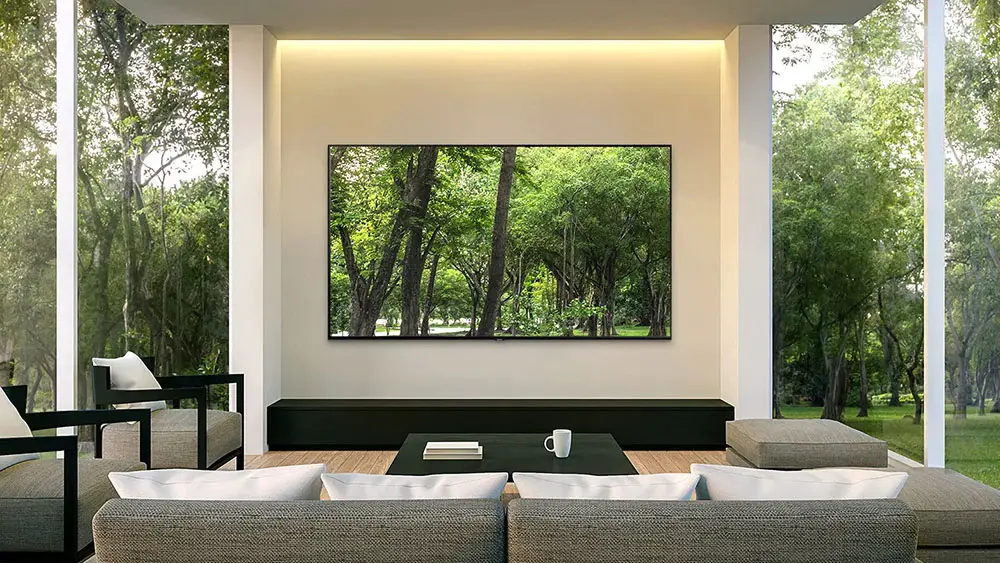
For more reviews you can check our dedicated 4K LED LCD TV reviews list or even look at our Product Reviews Table where you can find the brand and specific product you are looking for.
Cheapest Places to Buy :
*We are a reader-supported website. When you buy through links on our site, we may earn a small affiliate commission at no extra cost to you. Home Media Entertainment does not accept money for reviews.*
Thank you for this excellent review about Samsung Q70R. Well, I’m not really a big fan of specs and others. I just want to change my television at home and a friend suggested this to me so, I decided to have a quick glance through it. Well, I can say I’m pretty convinced by the huge features you have highlighted here and surely, it fits in well with my budget. Thanks
I hope our review provided you with all the information you needed to make up your mind. If you need any additional help let me know.
Hi Stratos!
Great and very detailed review! Before reading this, I hadn’t ever before considering all these factors when buying a TV, my family just takes them a looks, sees the price and then considers whether to buy or not. But from now on, I will try to pay attention to the details like the brightness and contrast of colors, the lightning and image quality. It’s a pity that they have removed the one connect box, I didn’t know they weren’t in the latest models. My family bought not long ago a new Samsung TV and had the one connect box and for me, it is very practical than having to put all the cables to the TV’s behind part. Do you think this device is already dead or they may include it in the future again?
You provided with a lot of information and probably you helped anyone who was considering buying this TV.
Best,
Mariana
Hello Marianna. It seems that Samsung is using the One Connect Box only on their top flagships. We would like to see it being used in more of their models but this would probably mean a higher cost also. But its a feature that is worth it and we would prefer to pay a bit extra to have it.
I am definitely not a TV Fundi or a gamer but I do enjoy a great Rugby game or a movie. I have had a number of TVs over the years and only recently upgraded to a smart TV. The one issue I have had with it is lag time and your article has really made me more aware of it.
Maybe it is now time for me to upgrade to a better TV. It would certainly excite my grandkids who are avid gamers and always complain about my TV. The Samsung Q70R sounds like it is a good choice.
With its extremely low input lag the Q70R is perfect for gaming Bryan. You cannot go wrong with it.
Hi Stratos…
I’d like to know your opinion on if it’s better the LG sm8600 or Samsung Q70R both 65″ i was pleased with the Samsung but my retailer guy showed me the LG and a second guess my first choice. So i come to u if can help me. Thanks
Greetings Luis. I am here to help you so don’t worry. I will analyze you the strong points of each one so it can be easier to distinguish the differences between the two.
The Samsung Q70R uses a FALD system, has better brightness in both SDR and HDR content and supports HDR10+. On the other hand the LG SM8600 has better viewing angles and supports Dolby Vision.
Both TV models have similar color coverage and input lag. As for their smart TV functionality we consider them almost equal as both Tizen and webOS are equally good.
Now if you want my honest opinion I would go for the Samsung Q70R as I would choose any FALD TV over an Edge-lit one. And overall the specs are better on the Samsung. Yes, it’s missing Dolby Vision but I would consider this the only real minus of the Samsung. Otherwise it’s better than the LG.
I hope my answer helped you. If you need any further assistance let me know.
Thank u Stratos for your fast feedback. I appreciate your input, similar to my first option. Again I balance mostly because of Vision and Atmos, although my AV don’t support Atmos. I like more the colors and overall image of Samsung, probably because I’m used 2.
Just one other thing… I might buy the LG for 1000 €… a less cheaper today than the Sumsung. Last time I checked Samsung were near 1700€, last weekend around 1300€. I’m hoping the price drops on Samsung over Black Friday.
No problem Luis. Let me know if you need any further help. Maybe you will be lucky with the Black Friday deals. May I ask what size you are looking for?
I’m upgrading to a 65”.
Do u still think that with this gap of prices the Samsung is a better choice?
For 700 euros for sure no. But if the difference is around 200-300 euros max then yes I would say it is worth it.
Ok Stratos thank you for your input. I’ll let you know if my choice. And if I have any other question I’ll be around. Once again thank so much
You are welcome Luis. Wish you happy shopping! 🙂
Hello again Stratos…
Last night I went to buy the Samsung and once again the seller came with a suggestion and got me confused.
So I’m seeking again your opinion on this. Is the Sony KD65XF9005 better than the Samsung 65Q70R? Both coasts 1200€…
What’s your opinion ? And again sorry to bother u with this …
Hey Luis. You never bother and I am really pleased to be able to help you. It seems the seller is doing anything he can to drive you away from the Samsung hahaha. The XF900 huh? Ok let’s see how these two fare in comparison.
The Samsung Q70R has better contrast, lower input lag and supports HDR10+.
The Sony X900F (or XF900) has 60 dimming zones (vs 48 of the Q70R) which means more accurate light control and less blooming, has better brightness and supports Dolby Vision.
Similar to both are viewing angles and color coverage. If I had to choose between the two I would go for the Sony Luis. It is obviously better when it comes to image quality so since you can find them in the same price go for the XF900.
Hope my answer was clear enough 🙂
LOL… my thoughts exactly Stratos. The seller as probably something against Samsung. I saw both working yesterday and doubt got me… i didn’t knew Triluminos was the same as Qled, and the Sony as Dolby Vision too.
So tell me something… i also saw for the same price 1200 a Sony LED 65″ KD-65XG7096… is this model inferior than the XF900 ?
If this is the Sony XG70 we are talking about then don’t even think about it. It is vastly inferior to the XF900 and I cannot believe these two have the same price. The XG70 is supposed to be the lowest 4K TV in Sony’s arsenal for 2019. There is no comparison between the two.
I see…
So and about the difference between Triluminos and Qled… are they really the same with different names?
Basically it’s the same tech with each company’s proprietary naming.
Sony calls it Triluminos, Samsung calls it Quantum Dot and LG calls it NanoCell.
Ok having your opinion in mind I’m going to choose most likely the Sony, sadly I can’t go for the Oled Models. Once again thank u so much for your input, a great help. All the best and season greetings. Hoping not having another suggestion from the seller. Lol
Yes from the models you mentioned the X900F is the best one to go with. OLED is great but also pricey unfortunately.
I am glad I was able to help. Let me know of your impressions from your brand new purchase 🙂
Hi Stratos
Hope everything’s ok with you.
And finally with my Sony 4K television home. It arrived Tuesday. Nice piece. Bigger than I expected. I’ve seen it on store but at home it’s a different story. But perfect for my movie room.
After two days it’s still hard for me to get used to a Sony. I’m a Samsung user for more than 10 years and the colors are different. I’m trying a few set ups online but still nothing extraordinary.
I’m some how disappointed with cable. My HD channels are good but still not great as I expected. I might upgrade my cable to 4K. Do you think that improves the quality or no need to?
I have an issue with the audio. All my equipments are connected to my Pioneer AV and from it to the TV. The Pioneer upscales to 4K.
From the tv I have a optical cable to the AV for sound using an external HD connected to the TV but here lies the problem.. I only get stereo from my MKV files. Can’t find on the tv where to unlock DTS.. any suggestion?
I find the Android so confusing. Too many steps for simple things like getting access to the HD.
I was wondering if you have any settings to calibrate the tv you can share or recommend, I’d appreciate the help.. or any suggestion for a neat tv picture…
So once again thank for your time and sorry for the loooooong text.
Hello Luis. It’s good to see you again here and with your brand new TV I see! Yes in the store TVs usually show smaller than in our houses, I felt the same when I had bought my Samsung some years ago!
Now for your first comment regarding cable quality. To be completely honest with you I use my TV only with either Blu-ray and UHD disks or Full HD and 4K files streaming through my Zidoo X9S media player. I never see streaming or broadcasting content because, no matter how you see it, quality is bound to be inferior. Upgrading to 4K will for sure improve things but by how much it’s hard for me to say.
One small question before I tackle your second problem. Why you upscale to 4K from the AV receiver and don’t let the TV do the upscaling. Some AV receivers can do really good 4K upscaling but not all of them and is surely better to leave the TV do the upscale of the signal to 4K and have your AV receiver only pass-through the signal.
Now for your MKV sound problem. I assume that the MKV files do have DTS and not just stereo, right? Have you tried other files with surround audio? Does everything come out only as stereo? You can check a couple of TV settings and let me know the results. Press the HOME button, then select [Settings] — [Sound]. In the Speakers settings set that to Audio system. Now after that try the different options in the Digital Audio Out setting that is a bit further down in the same menu and let me know about the results.
As for Android, yes it takes a bit of getting used to. Android has improved greatly the last few years but it still slightly lags behind Tizen and webOS. As for picture settings there are too many of them to name here but a pretty good one is HERE. Don’t be certain that these are the absolute best options as each panel is different and during our testing we chose a few different options than those mentioned there but more or less they give good suggestions and should be close to their optimal quality.
Hello again Stratos…
Before I’ll test your input, clear my mind on something… The XF is LCD or a LED television?
Is there a difference between them?
Technically all TVs are LED LCD TVs. It’s a mistake to either call them LCD TVs or LED TVs. All flat TVs with the exception of OLED use liquid crystal panels that come with some short of LED system. That’s why the LED LCD TV term.
I have written a detailed article about your question and you can read it HERE. Hopefully it will solve all your questions regarding these different TV terms.
Morning Stratos…
Great writing I got the ideia.
My original question was because I’m concerned with the definition of the XF… and thought there was a difference… being the led more detailed than the LCD which I thought was old tech.
I still haven’t tested those setting from Rtings, but I will no doubt.
You asked me why I have everything connected to my AV… and not to the TV which in your opinion makes a better 4K up scaling … that was the way I had with my previous TV and because I’m streaming some MKV files from my Mac using the Infuse App on Apple TV and just like that I get a better sound. I can passthrough Atmos and get DTS HD Master even on my blu-ray connect to the AV with HDMI… that makes sense to you?
With the Sony I tried to connect Blu-Ray to the tv and cable too to see if I get a better def but I only get stereo on audio… ?? any reason for this?
In your opinion I got a better image resolution if all equipments we’re connected right on the TV?
You said that upscaling was done by the AV receiver, that’s why I asked. Why you didn’t let the TV do the upscaling instead.
In my opinion the best way to make connections is to connect everything on your AV receiver but not do any video upscaling. Just pass-through the signal so the X900F can upscale the image to 4K resolution.
Hi Stratos, happy new year.
All the best for you and your family.
I finally have a really good settings for my Sony XF9005 and after a long debate with you I’m pleased with the image. Looks great, and for that I thank you both for your time and patience.
But unfortunately I have one other issue that bothers me… DTS decoder.
I have, as you know, everything connected to the Pioneer AV, but to watch some MKV files I have to connect a HD to the television, some files I simply can’t stream for now, like 4K… and here lies the sound problem… the XF9005 decodes DTS but my receiver only gets 2.0 stereo… so my question to you is… is this normal or i should get DTS even when the file has DTS HD Master Audio? I’m asking because with my previous TV a LED Samsung I got that. What am I doing wrong… if anything…
Keep in mind that I haven’t change nothing on the receiver from my previous settings with the Samsung… is this a problem with Sony?
Once again thank you so much for your patience.
Hello Luis and Happy New Year to you too! I am happy that you finally managed to get the image quality that satisfies you.
Now as for your DTS problem. There are many things that could be wrong. Have you used the HDMI ARC port on both the TV and the AV Receiver? Have you checked what type of sound output is set in the settings? Does this happen only with DTS or with Dolby Digital tracks also? Check these first and we will go from there.
Also I will be completely honest with you when I tell you that using the built-in media player is not the ideal way of playing any kind of content. If you would ask me I would suggest you to buy a dedicated media player that you connect to your AV receiver and will play all your external files. It will save you a lot of frustration to be honest. At least this is what I am doing and didn’t have any problems so far.
Hi Stratos,
Many greetings from Croatia (Europe).
I’m buying a TV on sale.
I wonder how much you really see the difference on the samsung 75Q70R compared to the 75Q60R,I mean local dimming vs edge,whether it is so obvious, or ??
What do you think of this TV :PANASONIC TX-75HX940E ??.In Europe, Panasonic is still selling.
Thank you.
Hello Kresimir. Regarding the FALD vs Edge LED question I would say that is obvious in very specific situations. As I wrote in my review usually the better system shows when you have a relatively dark background and at the front a very bright small object appears. A FLAD system will handle the light of the panel far better and with more precision than an Egde LED one as in the Q60R. Obviously it’s not a day and night difference but it is there and at least in my eyes is an obvious one.
As for your second question one thing that we regret here in Home Media Entertainment is that we have so far neglected the Panasonic TVs which is a shame to be honest as they have released some amazing TV models lately. The one you mention we haven’t tested but we have decided to rectify this by making some reviews on their latest models soon. It’s also a real shame these are only for Europe as I know many people in the US miss this brand.
Keep checking back and we will make sure to add a few Panasonic TV reviews when we get our hands on some of them.
Hi Stratos,
Thank you for your answer, and I agree with that.And I’m a big fan of movies, home theater, just like you.I’ve been in it for 25 years.
Just one more question. Samsung75Q70R or 82Q60R ? or maybe Sony 85XG850. ?
I mostly watch movies and sports.
Well in terms of pure image quality the Q70R is the best from all three with higher brightness, better color coverage and using a FALD light system. Now if it was me I would prefer to sacrifice bigger size for better quality so I would definitely go for the 75″ Q70R.
Hi Stratos!
Came across your site recently and I must say the reviews are excellent and very detailed, I’ve spent a lot of time reading them and they’ve been very helpful. I feel much more knowledgable of the market after reading them 🙂
I’m looking for a tv mainly for watching youtube/tv, but also for gaming. Ideally I’d have around 43 inch but from reading the reviews I know most tvs this size lose some important features. Therefore if this is the case then up to maximum 49 inch would be fine.
The perfect tv would be the LG CX 48 inch as it has high hz/low input for gaming and most importantly OLED looks so amazing with deep darks and bright colours, its a big step up from everything below. However it’s too expensive for me so I’d like the closest thing. From your sites reviews and from the specs (eg FALD/HDR) I’ve been mostly looking at the Q60T, and the Q70R.
I think the Q60T is compromised and so finding a used Q70R would be the best balance of all factors. I could also wait for something in future or go for something else I’m unaware of but wanted to ask your opinion.
Thanks, Daniel
Hello Daniel. So basically you want a TV under the 50″ size and to be less expensive than an OLED. From Samsung your options are the ones you mentioned, the Q60T or the Q70R. But the Q80T also comes in 49″ size. Have you considered this, or is it too expensive for you still? From LG I cannot suggest you one as the only model under the 50″ size goes very low in specs. As for Sony the X950H comes in 49″ size also and it’s also a good consideration.
So just to keep everything clear. As more expensive suggestions you can look for either the Samsung Q80T or the Sony X950H. If any of these two are still very expensive for you then look for the Q70R and as a last resort the Q60T.